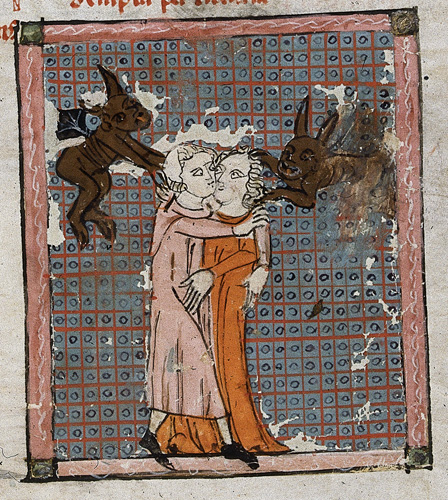Although Notches is a blog about the history of sexuality, as a historian of the late medieval Church I spend most of my time thinking about a group of men who were not supposed to engage in any form of sexual activity: the medieval clergy. The ideal of clerical celibacy was already centuries old by the dawn of the second millennium, but only from the late eleventh century onwards was it expected that all Roman Catholic priests would live in a state of chastity. On a basic level, this simply meant that priests were not allowed to marry or to have sexual relationships. For many clergymen, satisfying this requirement was probably tricky enough, but the holiest men went much further, attempting to achieve complete bodily purity.

Medieval theologians were extremely worried by the potential pollution of the priestly bodily by involuntary nocturnal emissions of semen; some even questioned whether a priest who had experienced such an emission should be allowed to celebrate mass. According to medieval medical theory, once semen was produced it had to be expelled in order to restore the humoral balance of the body. Ideally, this would be achieved through intercourse with one’s wife, but the male body was no respecter of marital status, and thus celibate men would experience nocturnal pollutions. On one level, such emissions were no more than a necessary rebalancing of the humours, but they could also be a sign of sin – especially if the individual concerned had in some way caused the incident, perhaps by engaging in improper thoughts.
Fortunately for the medieval clergy, there were a number of ways in which priests could increase their resistance to sexual temptations of all kinds. Many of these strategies were based around avoiding sources of temptation (especially the company of women), and focusing the mind on spiritual matters. Some holy men mortified their flesh, most commonly by wearing a hair shirt. Since lust was thought to arise from the heat of the male body, it could sometimes be suppressed through the use of cold water. Some pious individuals are said to have poured cold water over themselves before going to bed; the most devout went even further. Aelred, abbot of Rievaulx, had a small chamber built underneath the novice house, into which flowed water from the nearby river. He regularly ‘immersed his whole body in the icy cold water, and so quenched the heat in himself of every vice.’ Theories about the interchangeability of bodily fluids meant that devotional weeping could also be interpreted as an aid to bodily purity, with the holy man’s tears drying up the moisture from which semen was formed. Less dramatically, diet could also serve as a weapon in the battle for chastity. Whilst some foods (including meat and eggs) were thought to increase the production of semen and provoke lust, others (such as the fish which formed a staple of the medieval monastic diet) had the opposite effect.
Religious faith and medical knowledge undoubtedly helped some medieval priests to remain celibate, and even to achieve the bodily purity which characterised medieval saints. But for many clergymen the strain of achieving the impossibly high standards expected of them must have been terrible. Many succumbed to the temptation of illicit relationships, whilst others went to terrible lengths to avoid them. Few stories can be sadder than that of John Albyston, a fifteenth-century priest of the diocese of Worcester, whose struggle with lust led him to castrate himself. In the middle ages as today, human sexuality could be a source of pleasure, but also the cause of great pain.
 Katherine Harvey is an Associate Lecturer at Birkbeck College, University of London where her research focuses on the pre-Reformation English episcopate. Her first book, Episcopal Appointments in England c.1214-1344, was published by Ashgate in January 2014. Katherine’s current project combines ecclesiastical history with the history of gender, sexuality and medicine. She tweets from @keharvey2013
Katherine Harvey is an Associate Lecturer at Birkbeck College, University of London where her research focuses on the pre-Reformation English episcopate. Her first book, Episcopal Appointments in England c.1214-1344, was published by Ashgate in January 2014. Katherine’s current project combines ecclesiastical history with the history of gender, sexuality and medicine. She tweets from @keharvey2013

NOTCHES: (re)marks on the history of sexuality is licensed under a Creative Commons Attribution-NonCommercial-NoDerivatives 4.0 International License.
Based on a work at www.notchesblog.com.
For permission to publish any NOTCHES post in whole or in part please contact the editors at NotchesBlog@gmail.com




